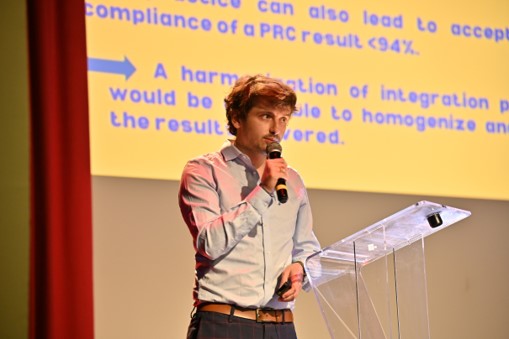Radiochemical purity calculation: analysis of the variability of manual integration on result rendering, towards a harmonization of practices
5 October 2023
R. Bodin1, C. Smadja1, A. Dowek2, C. Balouzet1, A. Hausser1, C. Hu1, E. Barre3, P. Leclerc4, S. Marie5, V. De Beco6, B. Sabatier11 Service Pharmacie, Hôpital Européen Georges Pompidou, AP-HP, Paris, France
2 Université Paris-Saclay, Lipides : systèmes analytiques et biologiques 91400, Orsay, France
3 Service Pharmacie, Hôpital Saint Louis, AP-HP, Paris, France
4 Service Pharmacie, Hôpital Beaujon, AP-HP, Paris, France
5 Service Pharmacie, Hôpital Kremlin Bicêtre, AP-HP, Paris, France
6 Service Pharmacie, Hôpital Avicenne, AP-HP, Paris, France
 Introduction
Introduction
A radiopharmaceutical preparation (RPP) consists in binding a radioelement to a carrier. Each RPP requires going through a control process based on the measurement of radiochemical purity (RCP), defined as the proportion of the radioelement bound to the carrier. It is determined by thin-layer chromatography (TLC) coupled to a radioactivity detector. The aim of this work is to assess inter-individual variability in the manual integration of radiochromatogram (RCM) peaks in the calculation of RCP and its impact on RPP compliance.
Materials and methods
The radiopharmacy laboratory of our hospital prepared and controlled 15 MIBI-(99mTc) RPPs. The threshold value and control method for RPPs are described in the summary of product characteristics (SPC). For MIBI-(99mTc), the RCP must be ≥ 94%. The RCMs were obtained using Raytest’s miniGITA® system and sent to 5 radiopharmacy units in our region, then integrated and analyzed by 10 participants (1 technician, 2 externs, 1 intern and 6 pharmacists). The results of these integrations were interpreted by analyzing the coefficients of variation (CV) on the RCPs calculated and the operators. A Cochran’s C test was performed to determine the presence of extreme variance.
Result Discussion
In this study, 15 RCMs were analyzed for 149 RCPs calculated, 1 operator rejected a RPP before the RCP was calculated. Of the 15 RPPs, 6 were consensus releases (4 compliant, 2 non-compliant). The other 9 RCMs had particular characteristics: 3 left a front-tailing, 3 with unclear spread peaks, 3 with high background noise, leading to operator-dependent integrations. 7 RPPs (46%) had CVs on RCPs below 5%, 4 (27%) between 5 and 10% and 4 (27%) above 10%. The intermediary fidelity coefficient was 8.3%. According to Cochran’s C-test (Cmeasured = 0.458 > Ctable = 0.215, p = 0.05, k = 10, ddl = 14): there was at least one extreme variance in the distribution of RCPs. Despite these variabilities the majority of RCMs were declared compliant (116; 77%) including 31 RCMs (26%) with a RCP < 94%.
Conclusion
This study highlighted the fact that manual integration of RCMs was operator-dependent in the majority of cases. These situations are frequent and occur when peaks are spread out, with front tailing, or for RCMs with a high background noise. This practice can also lead to accept the compliance of a PRC result < 94%, taking into account the aspect of the measured RCM. A harmonization of integration practices, with definitions of background noise integration zones and detection thresholds, would therefore be desirable to homogenize and secure the results delivered.